Prior to World War II the Japanese experimented with culturing commercial sponges in Pohnpei, Chuuk (formerly Truk), Palau, and the Marshall Islands (Smith, 1947). The work they were doing with the sponges was terminated by the outbreak of the war and the sponges were left to their own resources. The commercial sponges in Pohnpei's lagoon used in these experiments have since spread to many different locations within the lagoon, and have been thriving
The author started looking into the possibility of culturing commercial sponges around 1979. He spent the next several years locating wild stocks in the Pohnpei lagoon and with developing techniques for culturing sponges.
In 1986 the FSM Government started to investigate the possible potential for sponge farming and contacted many outside agencies for information. Samples of the commercial sponge found on Pohnpei were sent to different agencies for identification and the reports received stated the samples sent were Spongia officianlis (as it turns out not the correct name - see below) which is the same or similar to species of commercial sponge marketed elsewhere. As noted above, prior to 1940, the Japanese in Micronesia experimented with culturing commercial sponges (Smith, 1947 Cahn, 1948). One document indicates the sponges used were found already growing in the various lagoons (Cahn, 1948). Mr.Smith sent a sample of the Micronesia sponge to Dr. M.W. de Laubenfels, a noted sponge biologist, and Dr. de Laubenfels reported “The specimen is Spongia officinalis, subspecies mollissima, known as Fine Levant or Turkey Solid. One expects to find this exclusively in the eastern Mediterranean, and it is absent or rare elsewhere in the world. The specimen is one of the finest I have seen. Its fibres are a little bit weak, perhaps as a result of chemical bleaching, but in general it is worthy of enthusiasm. This is the sort of sponge that is suitable for some of the highest-price use, such as for blood absorption in surgical operations. I have tested it carefully, its elasticity, holding power, and all-round “sponginess” are superlative” (Smith, 1947). Mr.Cahn also sent samples to Dr. de Laubenfels who identified these samples as Spongis officinalis Linne. Dr. de Laubenfels considered this sample to be close to the variety mollissima, and he felt a new variety or subspecies should be established for them. He considered them to be the West Pacific equivalent of the fine Turkish sponge (Cahn, 1948). During mid 1987, Mr.Mike Gawel, FSM Division of Marine Resources, sent a sample of the sponge found in the Pohnpei lagoon to Professor Gerald Bakus, University of Southern California, and Professors Bakus responded “The sponge you sent me from Pohnpei seems to be the worldwide commercial tropical sponge, Spongia officinalis L. The taxonomy of Spongia is in poor shape and a revision of the genus is needed” (Professor Gerald Bakus, personal communication).
During 1994 the Centre for Tropical and Subtropical Aquaculture (CTSA) based in Hawaii, funded work by sponge taxonomist Dr.Michelle Kelly Borges, currently working for the London Natural History Museum, London, England, and she has positively identified the sponge being cultured on Pohnpei as Coscinderma mathewsi.
Under a project sponsored by the SPADP during 1989, the author completed a survey of the Pohnpei Lagoon looking for concentrations of commercial sponges. No concentrations were found outside of the one known sponge bed located on the north side of Pohnpei Island. This sponge survey showed there are many locations within the Pohnpei Lagoon where commercial sponges can be cultured.
The SPADP also sponsored a visit by a noted tropical sponge biologist, Dr. Clive Wilkinson, Australian Institute of Marine Sciences, to advise the FSM Government on sponge culture. The report received from Dr.Wilkinson states that assuming the quality of the Pohnpei commercial sponge is sufficient to attract a good price on the international market, “there is high potential that a sponge farming venture in the lagoon of Pohnpei would be successful in producing a cash crop for fishermen” (Wilkinson, 1989).
However, Dr.Wilkinson also states “Stocks of parent sponges in Pohnpei are limited and will not sustain exploitation of the wild stocks and may not be sufficient to sustain a farming industry on a prolonged basis, if not systematically replaced.” (Wilkinson, 1989) He goes on to say “During my surveys of several sites in Pohnpei Lagoon, the only commercial-quality sponges were relatively large with no evidence of small sponges recruited to the population. Most large tropical sponges are very slow growing (Wilkinson and Cheshire, 1988) therefore it is apparent that the Pohnpei bath sponges have a very slow rate of recruitment. The implications of slow growth and low recruitment are that the wild stocks of sponges could not sustain commercial harvesting directly, therefore it is essential to farm the existing stock on a total replacement basis if a commercial sponge industry is contemplated.” (Wilkinson, 1989, p.14).
The SPADP also sponsored a commercial sponge marketing study undertaken by Ms Helga Josupeit. This report gives general information concerning world production and world markets. The report details import and export statistics. This report is available through SPADP, Suva, Fiji.
Under a project sponsored by CTSA, which started around 1990, the author established a small demonstration farm in Pohnpei's lagoon where both growth and survival rates were measured. Also under this project, a demonstration plan, detailing the steps necessary to establish private commercial sponge operations throughout the region was produced. This plan is currently being published and distributed by CTSA.
Under later phases of this CTSA project (completed March 1993) project personnel gathered three years of growth and other biological data, developed efficient cleaning techniques, and trained six potential sponge farmers in sponge farming techniques.
Using SK funds, obtained through the National Marine Fisheries Service of the U.S. government, four additional farmers in Pohnpei State were trained, commercial sponge markets were investigated, and extension work was started for all local commercial sponge farmers.
Several agencies, including the South Pacific Commission, the FSM National Government, Chuuk State Government, and the Government of the Marshall Islands, have combined resources to sponsor short, preliminary surveys within Chuuk Lagoon, within one outer atoll in Yap State, and several atolls within the Marshall Islands. Commercial “wool” sponges, similar to the ones currently being cultivated in Pohnpei, were found by the author, in small State Marine Resources personnel with establishing two small demonstration farms at Ulithi Atoll utilising “wool” sponges previously located by a Peace Corps Volunteer. During the survey of the Majuro Atoll no “wool” sponges was found. Samples of the “wool” sponge from Pohnpei were identified by several people in Majuro who said they have seen this sponge at least two atolls - Ailinglapalap and Ebon. A second trip to the Marshall Islands was undertaken during mid-1995 and one small sponge which looked like the one being farmed in Pohnpei was found by the author. Further work in this area is planned.
Information received from many agencies indicates the current demand for commercial sponges is far greater than the supply (one source stated the demand was five times the supply) and information received from at least one commercial buyer has verified this. During late 1986 a commercial buyer stopped off on Pohnpei and he viewed a small cleaned sample of the commercial sponge found here, supplied by the author, and stated it was called a “wool sponge” by the industry. Later the author travelled to Californed and to Florida where he showed samples to five different commercial sponge buyers (one in California and four in Florida). They all expressed an interest in purchasing cultured sponges. The value quoted ranged from a low of US$1.00 to a high of US$1.75 for a four inch sponge. Larger sponges would command a higher price. The California buyer stated he wanted at least 1,000 per month and the Florida buyers stated they wanted at least 100,000 per year. They all stated it was difficult for them to get enough natural sponges to meet their demands.
Commercial sponge aquaculture was attempted off the southern United States in the early 1900's but met with strong resistance by local fishermen. There was much vandalism (Sea Secrets, 1983). Sponge farmers learned there are no natural predators that can damage the sponges but they also learned that sponge farms are sometimes subject to a blight that will kill sponges planted very close together. The commercial culturing of sponges was also carried out at Andros Island, Bahamas, “ ....for the past 20 years or so.” per a 1957 report (Storr, 1957).
As noted above, within Pohnpei State the Japanese experimented with growing sponges just before World War II. They planted sponges on vertical lines and reportedly had some success with culturing them. The following diagrams show the various methods used by the Japanese during their sponge culture experiments throughout Mirconesia.
The Japanese tried a variety of culture methods starting off with the traditional “concrete disk” method which was used off Florida in the U.S.
The “concrete disk” method (Fig. 1) involved casting a concrete disk approximately 30cm in diameter and 5 cm thick. A small wire was inserted into the centre of the disk during casting and was used to hold the sponge cutting to the disk until the cutting could attach itself as it grows (Cahn, 1948).
AUTHORS EVALUATION OF THIS METHOD - While this method is the closest method to the natural growth of commercial sponges - attached to the bottom - it has several drawbacks. First, casting the disks takes a large amount of labor and materials causing a significant investment of time and money. However, the major drawback is this method greatly limits the locations where sponges can be cultivated. The disks can only be placed in areas where there is firm, non-shifting, sand. If placed in muddy or silty areas the disks will sink into the substrate and the sponge will be smothered. If the sand is shifting, for example, due to currents or wave action, the sponges will also be smothered and killed. Using this method, sponges could not be cultivated in areas where live coral is growing, unless one were willing to kill off the coral to make room for the sponges. Finally, using this method, sponges can only be cultured in water depths of from one to three meters, unless a farmer uses SCUBA diving equipment.
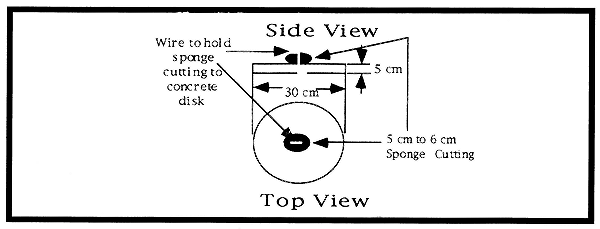
Figure 1. Concrete Disk Method
Another method tried was the bottom set method (Fig. 2). This method was an expansion of the concrete disk method. A frame, constructed from metal pipe or rods, was set into a concrete base and sponge cuttings were hung from the top of each frame.
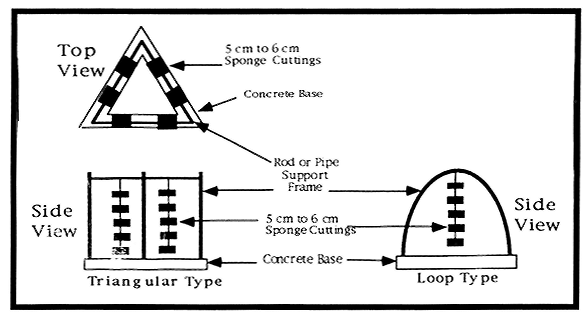
Figure 2. Bottom Set Method
AUTHORS EVALUATION - The same drawbacks which apply to the disk method also apply to this method.
The vertical raft method (Fig. 3) is a further expansion. Large bamboo frames were constructed and anchored on one end so they would float vertically in the water. Sponge cuttings were strung vertically between the bamboo cross sections.
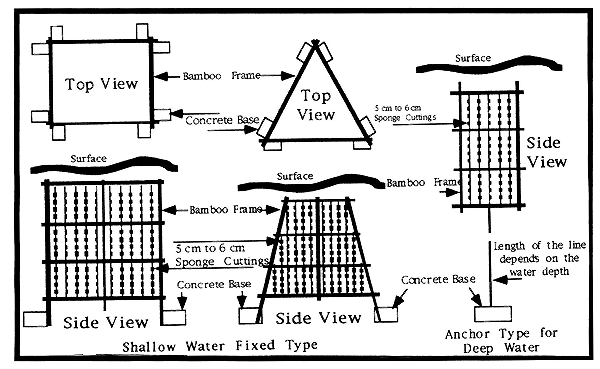
Figure 3. Vertical Raft Method
AUTHORS EVALUATION - This method requires a tremendous amount of labor to construct and, more importantly, to maintain the bamboo rafts. The bamboo will only last six to eight months in the water and then will have to be completely replaced. This is a significant problem as commercial sponges take two to three years to reach a harvestable size. The fixed type of vertical raft could only be used in relatively shallow water as the top of the raft needs to be close to the surface. The anchor type of vertical raft was designed to allow sponges to be cultured in deeper water.
The floating bottle method (Fig. 4) was the last method tried by the Japanese and reportedly had the best results (Cahn, 1948). Accordingly to Cahn, the Japanese reported this method produced the most rapid growth and had the best survival rates of all the methods tried. Cahn's report did not state why the Japanese felt this method was surperior to the vertical raft method which it closely resembles. The floating bottle method used a beer bottle to support a single vertical line of sponge cuttings.
Using the floating bottle method and the anchor type of the vertical raft method, a farmer can grow sponges in any depth of water, over any type of bottom. The fixed type vertical raft method can be used over any type of bottom but only in shallow water. The height of the raft is determined by the depth of the water. As noted above, the bottom set method and the concrete disk method can only be used on one type of bottom and only in shallow water.
The sponge culture experiments carried out by the Japanese within Micronesia were done around several high islands (Pohnpei, Palau, Chuuk) and within at least one atoll in the Marshall Islands. The work undertaken in the Marshall Islands indicates sponge culture is suitable for the outer atolls of the FSM and other islands nations. The trials within Micronesia indicated sponges could be grown with little difficulty.
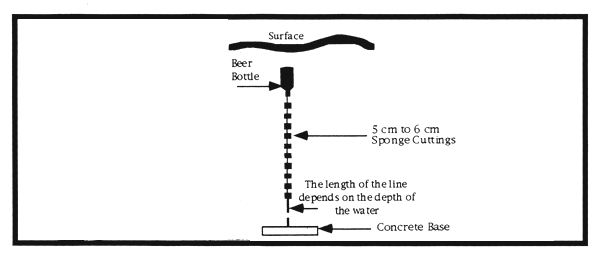
Figure 4. Floating Bottle Method
Beginning in mid-1984 the author has been experimenting with culturing commercial sponges within the lagoon of Pohnpei and has developed a low cost, low technology method for culturing commercial sponges on submerged horizontal lines (Fig. 5). Using this method, sponges can be cultured over any type of bottom in any depth of water.
Large coral heads, approximately two to three meters deep, are used to anchor the ends of 4mm ropes which are strung, approximately parallel, 12 to 18 meters apart (depending on the placement of the coral heads). Nylon lines, 150 lb. test, are strung between the ropes approximately 75 to 90 cm apart, and the sponge cuttings are hung from these lines using 50 lb. test nylon lines.
This is the method currently being used by all the commercial sponge farmers now operating within Pohnpei's lagoon. The lines used have proven to be quite durable as some are now more than eight years old and are still supporting their load of cultured sponges. Using this method a farm can be set up for a cost of approximatley $500 to $600 per acre, and a farmer can plant approximately 10,000 to 12,000 sponges within that acre.
Commercial sponges are slow growing animals. The 1948 paper by A.R. Cahn sited a minimum of one and a half to two years for a cut sponge planted in Palau to reach a minimum commercial size, “… as large as a fist.” (Cahn, 1948). Other sources have indicated a growth period of from three to four years to first harvest (Sea Secrets, 1983 and Stevely, 1985). The author has been growing commercial sponges on horizontal lines suspended off the bottom since 1985, and at the time of this report, has more than 20,000 commercial sponges growing on these lines. The author has also assisted five local family with starting their own private commercial sponge farms and at the time of this report they have a total of approximately 28,000 under cultivation. The work done by the author in Pohnpei indicates a growth period of from two to three years. While commercial sponges are rather slow growing they do show promise for being cultured and exported to both tourist and world markets.
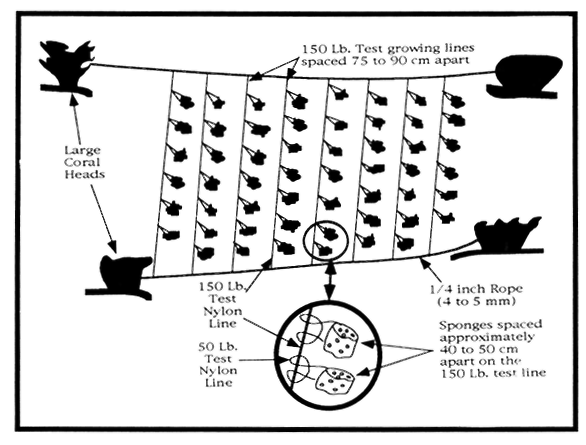
Figure 5. Horizontal Line Method
There are several disadvantages to growing commercial sponges. The first, is the long growing time. This is easily solved by simply planting a certain number of cuttings each year and establishing a planting/harvesting cycle. Once the cycle is established a farmer will be harvesting and exporting on a regular basis. It will just take time to establish this cycle. The only real potential problem which may be encountered during this long growing period is the possibility that some disease may appear during this time, as noted below. If this were to happen the potential impact would be reduced by quickly harvesting the effected sponges as well as the all those in the immediate area. This should reduce or prevent the spread of any disease to unaffected sponges.
As noted above, a potential problem is the possibility of disease. The wild sponges located off the Florida coast have suffered from a “blight” only twice in the past 90 to 100 years. Recent information received indicates that the same may now be happening, for the first time, to some of the commercial sponge stocks located in the Mediterranean. While this problem has only occurred two or three times over the past 100 years, there is always the possibility that some organism may attack a growing sponge and a close watch would have to be maintained for any sponges being cultured.
The biggest problem facing the establishment of a commercial sponge industry in any country is the availability of wild stocks of commercial sponges. Even in Pohnpei the wild stocks are not large enough to support commercial exploitation nor to provide sponge cuttings for more than one or two commercial farms per year. To develop a viable commercial sponge industry, unless very large numbers of wild stocks can be found within a country, it will be necessary for the local government to establish a nursery farm or farms which then can be used to train potential farmers and to provide trainees with the cuttings needed to start setting up their own private operations. This is what has been done in Pohnpei. Before any nursery farms can be established, a survey of wild commercial sponge stocks, as well as potential sponge farming sites must be conducted to determine their present status.
As indicated in the Summary section, the question was raised about importing wild stocks into Kiribati if no local wild stocks can be found. In general this is not a good idea as one has little control over what harmful organisms may be introduced with the wild sponge. This is of course a decision to be made by the local governments. If the decision is made to attempt an introduction this should be done very carefully.
One approach might be to collect wild stocks from a region outside Kiribati and completely isolate them in some kind of holding facility within Kiribati. It would be very important to insure the wild sponges are totally isolated, allowing no chance of any organisms from the sponges to get free into the Kiribati environment. After they have been isolated for a while samples of each wild sponge could then be analysed to determine if any harmful organisms may be present within the sponge. If none are found, it may be possible to introduce them into one lagoon within Kiribati and closely observe them.
Another approach might be to spawn sponges outside Kiribati and introduce the resulting “seed”. This would be a very technical, long term approach but would probably have the best chance of insuring no harmful introductions.